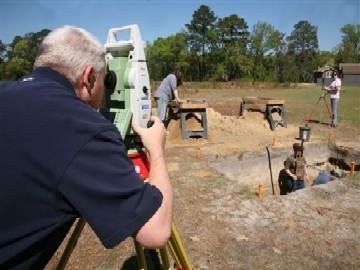
Section Branding
Header Content
Civil War Prison Camp Wall Uncovered
Primary Content

Archaeologists have found the remains of the Camp Lawton stockade wall, establishing the actual layout and site of one of the Civil War's largest prisoner of war camps.
Georgia Southern University, the Georgia Department of Natural Resources and U.S. Fish and Wildlife archaeologists with assistance from Kennesaw State University, the University of Georgia and the Lamar Institute made their discovery public on Thursday.
It was made at Magnolia Springs State Park located in Millen.
A significant portion of the southern wall of the camp was exposed along with a section of the western wall which enabled archaeologists to project the exact location of the southwestern corner.
The discovery was made late last week as the hit PBS television show Time Team America documented what was found and how archaeology helps tell the story of Camp Lawton’s history.
The park, along with University archaeology students and professors, will hold a public day this Saturday at the park.
The event will run from 9am to 3pm.
Visitors will have an opportunity to see the location of the stockade wall and discuss Camp Lawton and the television show.
"We found it. Standing where the corner of the Camp Lawton stockade once stood was one of the greatest moments of my archaeological career," said Sue Moore, Ph.D., professor of Anthropology in the Department of Sociology and Anthropology at Georgia Southern University.
A crew of geophysicists with Time Team America along with Georgia Southern and University of Georgia volunteers conducted a massive amount of research using equipment such as ground penetrating radar, magnetometry, conductivity and electro induction.
These different technologies look into the soil and their specific datasets assist archaeologists in locating areas of historical interest.
"In three days we conducted more geophysical research than most sites ever do. This laid the baseline for years of future research for Georgia Southern students," said Moore.
Georgia Southern University students and professors along with Time Team America archaeologists extracted several wooden timbers that were submerged in Magnolia Spring.
The location of the timbers is near the place where the Camp Lawton Stockade would have crossed the spring which still flows through the park today.
Core samples taken from these timbers will help researchers confirm they were part of the Camp Lawton Stockade. The largest of the timbers measured about five feet in length and weighed 400 pounds.
"Being part of the timber extraction was very interesting. It shows how archaeologists use multiple avenues to research the history of a site," said Blake Ayala, a Georgia Southern graduate student.
Archaeological investigation of the Camp Lawton Stockade in the Bo Ginn National Fish Hatchery continued during the recent shooting for the television show.
Work focused on uncovering more information about the more than 10,000 Union prisoners who were held in the 42-acre Confederate run prison.
A number of excavation units were opened to explore possible huts, known as shebangs, built by the prisoners.
The excavations revealed living surfaces and possible hearth features which when fully studied will shed light on the lives of the prisoners who were imprisoned at Camp Lawton nearly 150 years ago.
A metal detection survey, modeled on a gridded sampling technique which helped uncover the stockade three years ago, was used to further delineate the western limits of the prison occupation area.
This survey produced numerous artifacts which will reveal more about prisoner life.
"When this show airs next spring or summer, it is going to be an exciting one," said Moore. "These are major discoveries that will put Camp Lawton and Magnolia Springs State Park on the map. We hope that this work will attract tourism to the area to support the local economy."
The team is keeping quiet about the additional discoveries it made until the show airs.
Tags: Millen, Georgia Southern, GPBnews, orlando montoya, camp lawton, archaeology
